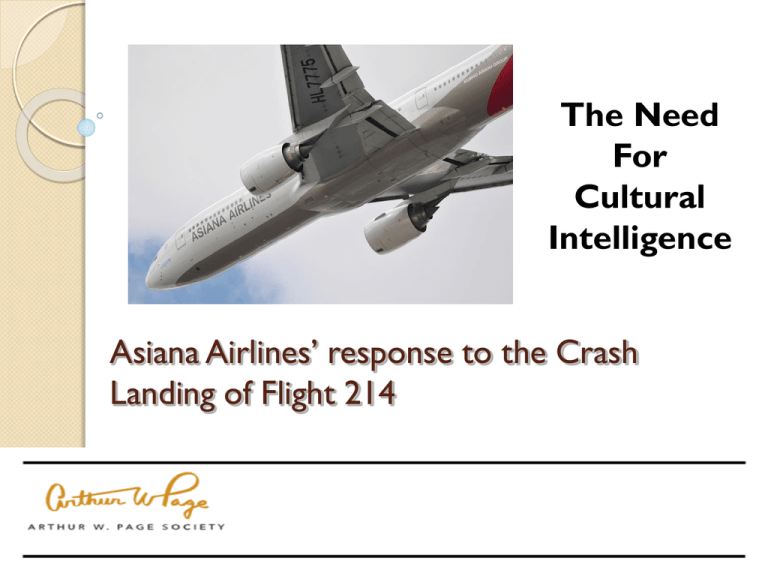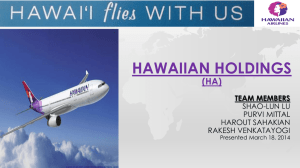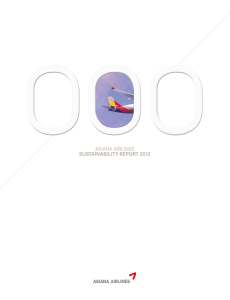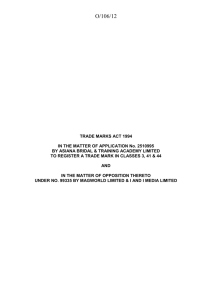Asiana Airlines - Arthur W. Page Society
advertisement

The Need For Cultural Intelligence Asiana Airlines’ response to the Crash Landing of Flight 214 History Company Overview: Founded: February 17, 1988 Current President & C.E.O.: Kim Soo-Cheon Headquarters: Seoul, South Korea Parent Company: Kumho Asiana group/ “Kumho Chaebol” Mission: “Uncompromising Safety” Awards: ◦ 2012 Business Traveler “Best Overall Airline in the World” ◦ 2010 Skytrax “Airline of the Year” History Past Crises: 1993 plane crashed in poor weather while approaching Mokpo airport in South Korea killing 68 July 2011, a cargo plane - a Boeing 747-400F - slammed into the East China Sea en route to China killing the only two people on board Asiana has not experienced a fatal crash in the western hemisphere. All Eyes on Asiana Airlines 11:27 a.m. on July 6, 2013 291 passengers 3 fatalities ◦ Two during crash ◦ One from fire truck Over 180 injured What media channel do you think viewers turned to as their immediate source of information immediately following the crash? Social Media Social Media Frenzy #SFOcrash Journalists and viewers go to social media for answers First witness post: within a minute of crash First Survivor Post: Less than 3 hours after crash What happened? (Source: The Huffington Post) S T A K E H O L D E R Communication to Media and General Public 1 p.m. – Boeing is first company to respond 3:50 p.m. – Asiana responds via Twitter 7hrs after flight – 1st press release 5 in total by July 13th No response to comments or media questions Turned a blind eye Plan for pilot training stated but no action S T A K E H O L D E R Communication to Victims/Families/Employees 3 days to dispatch CEO to apologize and go to SFO Denies support of crisis team to manage questions Automated reservation # created but fails= more emergency hotline numbers Reliance on United Continental Holdings Not much praise or information on employees besides initial tweet Statements defending pilots’ experience “My deepest condolences go out to the grieving family and loved ones of this passenger and to all those who have been affected by this regretful situation. We will devote all attention and efforts to support the families of the victims and expedited recoveries for the other injured passenger.” (Source: Asiana CEO) US Response to crisis 1. 2. 3. 4. 5. General Trends Lack of Timeliness Lack of Responses Social media engagement increase Lack of social media response Families sue airline Asiana’s response in Korea Several public apologies and news conferences in Korea. Issued few statements and offered minimal responses to U.S. audience. Threat to sue KTVU for on-air gaffe of racial prank Asiana Airlines blamed KTVU-TV and the NTSB for the false pilot report, stating that it "badly damaged" the reputation of the airline and its pilots. Do you agree? Asiana’s response in Korea Attempts to silence passengers ◦ Asiana reportedly instructed passengers not to speak with media. Asiana Airlines declined offers from U.S. communication companies to help deliver their messages stateside. “It’s not the proper time to manage the company’s image.” (Source: Asiana representative in Korea, when asked about the company’s response) Cross Cultural Communication Does Asiana Airlines need a stronger “Cultural Intelligence?” The ability to recognize and comprehend different beliefs, practices, attitudes, and behaviors of a group and then apply that certain cultural knowledge to attain your goals - whether those goals are political, business or otherwise. South Korean corporate culture “chaebol” culture Impact Financial Impact Asiana Airlines’ stock price dropped by ◦ 5.8% within a day ◦ 6.6% within a month ◦ All time low on April 12, 2013 Struggling footing to regain Impact Regaining trust. Asiana Airlines must earn back mission statement: “uncompromising safety.” Restoring credibility. Page principles 1.) Tell the truth Transparency with key stakeholders is vital to the success of an organization. It helps build credibility and reinforces trust within the organization. While Asiana Airlines’ always told the truth, the lack of timeliness made it seem as if the airlines was hiding something. The fact that the airlines would not meet with media spokespeople only added to this assumption. The messages from the airlines came off as rhetorical. The airline was perceived as unprepared and unsure of its actions even though the airlines’ message was consistent. The perceived failure to be transparent with key publics translated into a loss of credibility and in the long run, a loss of stock price. Page principles 2.) Prove it with Action You can say something as much as you want, but actions speak louder than words. From the start, the airlines communication was very one dimensional. With that, the airlines response lacked timeliness. While the messages were consistent, the messages sounded generic and were direct repeats from the press releases. In addition to this, besides a brief statement from the CEO stating he plans to improve pilot training, no actual action has taken place to insure the safety of the crew and passengers. By U.S. standards, the airlines failed to prove it with action. Page principles 3.) Listen to the Customer Asiana Airlines’ failed to meet the needs of all of its stakeholders. Based on U.S. norms, Asiana Airlines was not quick to understand what its listeners wanted or how they felt about the crash. What were the needs of the stakeholders in the aftermath of the tragedy? The primary need was providing a means to get updates about the crash and support for the passengers. Complaints from victims went left un-responded too. The company did not consistently provide real-time updates even as people requested more. As thousands posted questions on social media, the company did not respond to any of the questions or provide reassurance about the situation. The reliance on one-sided communication tarnished the airlines reputation and credibility. Creating some type of FAQ about the commonly asked concerns would have helped to ease the worries of some. Page principles 4.) Manage for tomorrow. Asiana Airlines failed to do this. The airlines neglected to anticipate public reaction to such a crash and the response to the crash. The opportunity to respond about any potential crash does not come about suddenly. Crashes are the first and foremost important thing passengers worry about when flying. Preparing for such a response, should have come easier. Asiana Airlines, being a leading international airline, had the time to do research and to realize the importance of sensitivity when it comes to global communication. Preplanned crisis communication responses that incorporated global and local trends and norms would have saved the airlines such backlash. It would have also made the support services offered to passengers and crew run smoother. Page principles 5.) Conduct public relations as if the whole company depends on it Asiana Airlines was one-sided in their public relation efforts. They even refused outside crisis communication assistance when it was offered by outside sources. They have a strong belief in internal communications; however, this does not take the entire company into account because Asiana makes more than half of its revenue from overseas flights. Public relations professionals should be capable of handling a wide of corporate communication activities. This was not exemplified from Asiana in the aftermath of the crash of flight 214. Page principles 6.) Realize the company’s true character is expressed by its people Asiana Airlines supported their employees after the crash. One of the first press conferences help of Seoul defended the pilots. In South Korean corporate culture, or chaebol culture, employees may be inclined to defend and remain loyal to their employers. However, it’s the corporations responsibility to uphold the relationship between quality and trust. Page principles 7.) Remain calm, patient, and good-humored In the case of Asiana’s response after the crash, the media wanted more of a stir from the arline. So in that respect, Asiana did keep a cool head when crises erupted. The efforts from the airline executives were calm and even-keeled. However, effective corporate communications requires dialog and conversations during difficult times, which Asiana failed to do. Know your audience: be culturally sensitive and possess cultural intelligence when communicating to your key audiences Engage in two-way communications with all stakeholders – internal, external, and globally Timing is crucial Do no under estimate the power of social media Be prepared









